- 웹진에 실린 글의 내용은 (재)예술경영지원센터의 의견과 다를 수 있습니다.
TEL 02-708-2293 FAX 02-708-2209 E-mail : weekly@gokams.or.kr
.jpg)
The Future of Art in the Age of Technology
- JiaJia Fei _The First Digital Agency for Art
JiaJia Fei _The First Digital Agency for Art
 예술경영 485호_2022.9.29.
예술경영 485호_2022.9.29.
The following text is a summary of the lecture that digital strategist JiaJia Fei delivered for ‘Special Lecture on Trend III’, organized by of MoAA (Management of Art Academy). The lecture took place on Saturday September 3, 2022 at COEX, Seoul.
As a digital strategist working at the intersection of art and technology for the last 15 years, I am often asked to predict the future. Although I can’t promise how accurate I’ll be, here are some thoughts on the future of art and how technology will shape how we experience it.
My good friend the artist Hank Willis Thomas once said, “when we are creating art, we are talking to the future.” When making art, artists are often making objects that will most likely outlast their own lifetime on this earth. Artists are therefore speaking to future audiences that they have yet to meet. And that’s really the purpose of a museum: the mission of museums has always been about preserving the past. A collection of objects that speak to a moment in time. The idea of technology within a museum, however, is a bit of paradox: Technology is new, and museums are not. Innovation in technology is always about the future—always iterating and creating the next version.
I first began working in museums at a time of radical digital transformation. As institutions started putting their collections online and establishing a presence on social media, they became aware of the importance of digital audience engagement, and job titles shifted accordingly. The word “Digital” began appearing in front of traditional job titles, such as curator, educator, and conservator. For audiences to know that you existed, you had to go digital, and map out a digital strategy to make that happen.
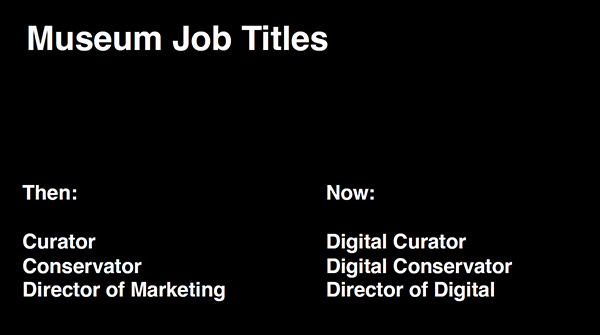
What is a digital strategist, exactly? In practice, my work leverages the power of digital tools (such as websites, social media, and digital content), but even more importantly, I consider myself an educator, a storyteller, and a translator. Why do we need translation in art? Too often, we see words on wall labels and press releases, describing the art you see at a museum or gallery, in language that is inaccessible. To reach new audiences, you must meet people where they are, and use language that is comprehensible to the average person. As technologists however, we are as guilty of the same thing. So many of the technical terms we use are just as alienating to our colleagues. As museum technologists, we must therefore be fluent in both art and technology if we want to leverage the power of digital to make art more accessible and bring it to a broader audience online.
Nearly 3 years ago, just 3 months before to the global pandemic when all museums and art spaces closed, I started my own digital consultancy to solve this problem in the art world, the first digital agency for art. Today, I work with a variety museums, galleries, and artists around the world to tell their stories online.
The foundation of my practice is largely centered around this mantra: if technology is the answer, what was the question? Before launching a “shiny product” or implementing technology for technology’s sake, I always ask my clients to identify the problem they are trying to solve, so we can use technology as a design solution. Why? Because the entire internet was built on this concept.
In an interview with Ev Williams, the co-founder of Twitter, he once said: “We often think the internet enables you to do new things. But people just want to do the same things they’ve always done.” Take a human desire, preferably one that has been around for a really long time…identify that desire and use modern technology to take out steps.”
If you look at every successful internet company today, all of them exist to solve an existing problem. And they accomplish this by helping people do what they already do but have leveraged technology to take out the steps. A singular technology solution now exists for nearly every human need… shopping (Amazon), ordering a car (Uber), ordering food (Seamless), calling a friend (Skype), Going on a date (Tinder), Reading a book (Kindle), watching a movie (Netflix), listening to music (Spotify)… all except for looking at art.
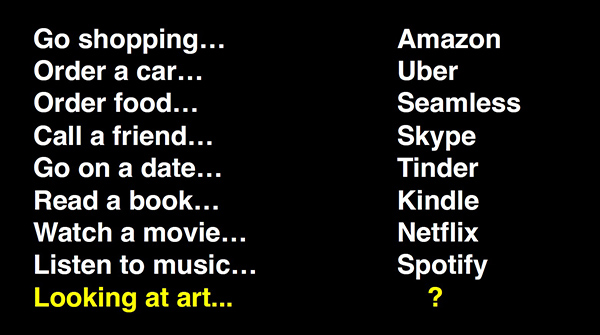
And that’s because the experience of looking at art is a bit more nuanced. Art is a multi-faceted experience. It could be a painting or a multi-channel video installation. It could be as intangible as a performance, or a digital object. Most importantly, art is an experience, and most of the time, it is a social experience.
Nevertheless, technology has radically transformed the way we see art. If we apply the logic of people wanting to do what they’ve always done before, the history of art tells a similar story: self-portraitrature today manifests in the form of selfies. Still lives have been the subject of artists for centuries, which are not unlike our own fascination with images of food. Claude Monet painted endless sunsets throughout his career, in the same way that everyone today whips out their phone the moment they see the colors of the sky, which continue to inspire and unify us. The subject matter of what interests us as humans may not have changed too much throughout history, but the ways in which we encounter these images has.
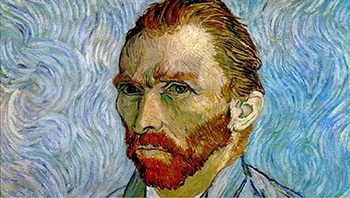
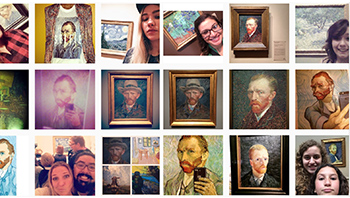
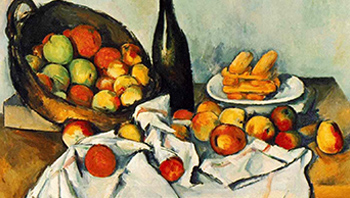

For the first time in the history of art, a work of art is seen online before it is ever experienced in person, because of the internet and social media. The scale in which this shift has happened is staggering: The number of social media users on Facebook, YouTube, Instagram, and TikTok alone now surpass the world’s most populous countries, like China or India.
Today, we see the visual world primarily through our screens, and increasingly, on our mobile screens. And because Instagram now wants to be like TikTok, the images and videos we see will become increasingly more vertical and optimized for the screen. Videos will also become shorter as our attention spans continue to diminish. We now live in a Google worldview, where our searches determine how we see. Pretty soon, I predict we will live within a TikTok worldview, as SEO on the platform quickly improves—to surpass Google search. By the end of this year, the time spent per day on TikTok by U.S. adults is expected to surpass YouTube.
TikTok is quickly becoming a key search and discovery platform for younger audiences. For institutions, it is therefore now critical to begin thinking about having a presence for this platform. This now begs the question: given all the changes happening to social media platforms that are beyond our control, should these changes begin to reshape the way artists present their work? And to what extent?
In the realm of artificial intelligence or AI, we are seeing incredible progress in art, especially. AI is no longer just being written into our algorithms and “For You” pages, computers are now able to generate hyper-realistic images written by code and machine learning, as recently reported in this story in the New York Times titled, “We need to talk about how good AI is getting,” which focuses on Dall-E, a web app developed by an American company called Open AI that turns text descriptions into images. Let me show you how it works: If I were to input the words “Painting of a K-Pop band on the moon,” or “Bibimbap made of rainbows,” I would get these results:
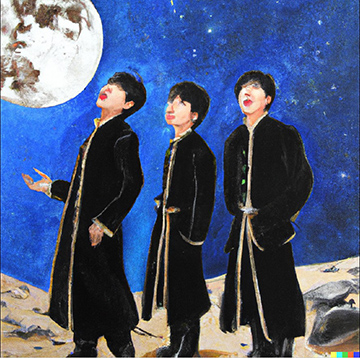
달에 간 케이팝 밴드 이미지(출처 : Dall-E)
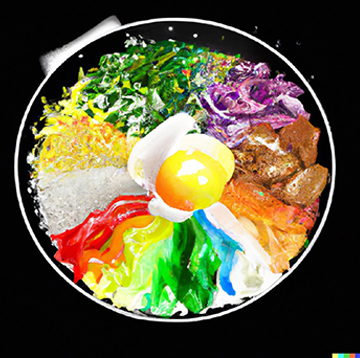
무지개로 만든 비빔밥 이미지(출처 : Dall-E)
AI is not without its dangers. Machines have the morality of their inventors. How do we stop replicating existing inequities of our physical reality in our newly formed digital realities?
Especially if a majority of the technologies we use are designed by a singular perspective (white male), this imbalance is especially present in the recent NFT boom / crash. NFTs and authenticating art on blockchain technology were a huge breakthrough in the representation and creating a market for digital artists, of being able to get money for previously unvalued work, and of being able to gain an audience for artists outside of geographic art capitals such as Paris, New York, or Seoul, but they continue to benefit the status quo. For example, at least 77% of NFT art sales are going to male creators. With every significant sea change in technology, we were promised a utopia in democratizing art and making it more accessible to more people. But instead, we just accelerated and exacerbated all of the issues in our present physical world.
Art has a long history of evolving in response to new technologies. Today, we might be complaining about NFTs. But I remember having a very similar conversation when social media emerged. And before that, the internet destabilized everything. You could even go as far back as the history of photography in art history. When the camera was first invented, it looked like a machine that automated the creation of art. It required no skill and would destroy high-quality art. What actually happened? A new art form was invented, with its own unique qualities. And photography continues to be a significant art form.
We are all extremely lucky to be alive at a time when artists can explore ever-more powerful tools: AI, AR, VR, and even NFTs and whatever the metaverse becomes. Personally, I see technological progress in our visual world as product upgrades. But there’s one thing I took away from the pandemic and global closure of museums and galleries: it’s the reality that people don’t want a virtual reality. People do not want to visit museums virtually! What’s the future of art int the age of technology? Thankfully, at the end of the day, technology will never replace the experience of looking at art.